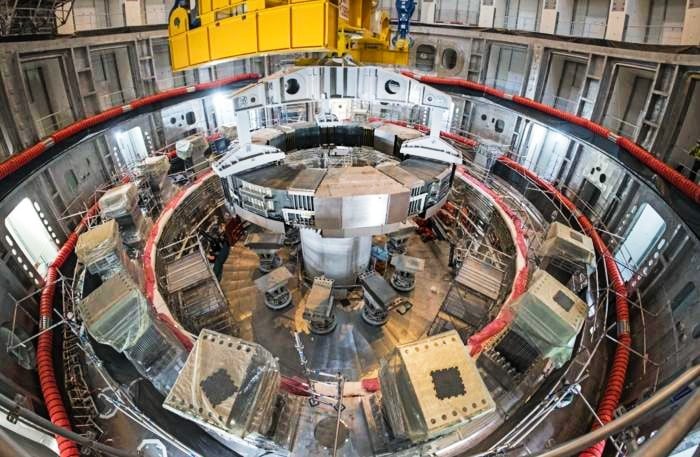A magnet strong enough to lift an aircraft carrier is now complete, marking a crucial milestone in humanity’s quest to harness the power of the stars. ITER, the massive international fusion energy project in southern France, has finished assembling all components for what will become the world’s largest and most powerful pulsed superconducting electromagnet system.
The final piece of this electromagnetic puzzle was delivered in April 2025 when General Atomics completed the sixth module of the Central Solenoid – a massive cylindrical magnet that will form the heart of ITER’s donut-shaped fusion reactor, known as a tokamak.
When fully assembled, this pulsed magnet system will weigh nearly 3,000 tons and generate magnetic fields 280,000 times stronger than Earth’s. These fields will create an “invisible cage” to contain plasma heated to 150 million degrees Celsius – ten times hotter than the sun’s core.
“The ITER Project is the embodiment of hope,” Barabaschi says. “With ITER, we show that a sustainable energy future and a peaceful path forward are possible.”
“What makes ITER unique is not only its technical complexity but the framework of international cooperation that has sustained it through changing political landscapes,” says Pietro Barabaschi, ITER Director-General.
The project represents an unusual geopolitical achievement: sustained collaboration between China, Europe, India, Japan, Korea, Russia, and the United States. These seven members have contributed components manufactured in hundreds of factories across three continents to build a single machine.
Engineers designed the Central Solenoid’s support structure to withstand forces equivalent to twice the thrust of a space shuttle launch. The entire system requires cooling to -269°C using liquid helium to maintain superconductivity.
The achievement comes as ITER reaches 100 percent of its construction targets, with most major components now delivered. In April 2025, workers placed the first vacuum vessel sector module into the Tokamak Pit ahead of schedule, marking another significant step forward.
When operational, ITER aims to produce 500 megawatts of fusion power from just 50 megawatts of input heating power – a tenfold energy gain that would demonstrate the viability of fusion as a power source.
Fusion works by combining hydrogen isotopes to form helium, releasing enormous energy in the process – the same reaction that powers our sun. Unlike current nuclear power, fusion produces no long-lived radioactive waste and uses fuel that’s abundant in seawater.
The magnet system’s completion represents years of precise engineering across multiple countries. The United States built the Central Solenoid and its support structure. Russia delivered the 9-meter-diameter ring-shaped Poloidal Field magnet for the top of the tokamak. Europe manufactured four Poloidal Field magnets in France, ranging from 17 to 24 meters in diameter. China created a 10-meter Poloidal Field magnet already installed at the bottom of the partially assembled tokamak.
Japan produced the superconductor strand for the Central Solenoid and eight of the Toroidal Field magnets. Korea manufactured thermal shields that separate the ultra-hot plasma from the ultra-cold magnets. India fabricated the 30-meter high cryostat – essentially a giant thermos – that houses the entire tokamak.
The raw materials alone are staggering: more than 100,000 kilometers of superconducting strand fabricated in nine factories across six countries. When complete, ITER’s magnet systems will store 51 gigajoules of energy.
As investment in fusion energy research surges in the private sector, ITER launched an initiative in 2024 to share its accumulated knowledge. In April 2025, the organization hosted a public-private workshop to collaborate on solving fusion’s remaining technological challenges.
“The ITER Project is the embodiment of hope,” Barabaschi says. “With ITER, we show that a sustainable energy future and a peaceful path forward are possible.”
The fusion experiment, when completed, will serve as a massive research laboratory for its member countries, providing critical data to optimize commercial fusion power plants in the coming decades – potentially offering a carbon-free energy source with virtually limitless fuel.
If our reporting has informed or inspired you, please consider making a donation. Every contribution, no matter the size, empowers us to continue delivering accurate, engaging, and trustworthy science and medical news. Independent journalism requires time, effort, and resources—your support ensures we can keep uncovering the stories that matter most to you.
Join us in making knowledge accessible and impactful. Thank you for standing with us!

